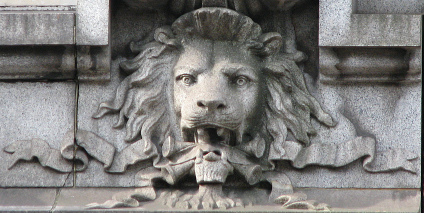
Sculptures of lion heads are among the most popular decorative adornments of buildings across England, and although these pages include one on lion sculpture in general, which has a sample of lions’ heads, I wanted to put together a separate page to give something of the range of types generally encountered.
Why are lion heads so popular in 19th Century and early 20th Century architecture? If we consider a hierarchy of sculptural adornment to buildings, then at the top we have free standing figure sculpture, in pediments, or on balustrades, or as groups or in niches. Next are the high relief figures, as friezes or in panels, or spandrel girls above arched doorways. After that are cherubs, keystone heads, and miniature figures of the sort that might be incorporated at the top of a pillar or among the foliage of a sculpted floral design. It is at this level, above the minor repeating decorative ornament, more individual than the plain pots and acorns and other termini of non-animate sculptural decoration, that I would tend to place the lion’s head.
Of course the lion is rather special – it is both the archetypical king of the beasts, and a symbol of Britain, used in great free standing sculptural groups such as the lions on the Victoria Memorial, through to groups of Britannia and the Lion (see the Britannia page). The lion represents the qualities of bravery and valour and nobility, and strength and fierceness and gravitas. In architectural sculpture, then, I think the lion head can serve several purposes: as subsidiary decorative sculpture on a grand building with some full sculptural group as a centrepiece; to give any of the characteristics noted above to a lesser building without major sculpture; to indicate a principal entrance or centre to a building; and to indicate Britishness, as in a civic building or bank or other building put up for an organisation wishing to have connotations of patriotic feeling. And we should not forget the purely decorative lion head, taking advantage of the mane as an opportunity to give novel shapes and contrasting surfaces to an ornamental design.
The examples above are typical of lion head sculpture adorning bank buildings. They show a variety of treatments – naturalistic for the one under the arch, traditional in a pre-Victorian style for the one on the right, which has a boldness and simplicity of carving to the mane which is particularly well conceived, and with stylised concentric curls in the mane for the one on the left. All three show another frequent characteristic of lion head sculpture – the grasping in the jaws of a ring or wreath or garland. It seems right and natural as we look at them, but as soon as we think about it, we realise that it is a particularly unlikely concept, which we accept because it has become conventional.
Above are some fairly naturalistic lion head sculptures, with the mane somewhat approaching the look of a real lion, likewise the face, and nothing unnatural within the mouth. From the left, the first four show the mouth closed, and then in various stages of opening; the fourth one, above a doorway and with mouth gaping wide open, despite its mane has something of a tigerish look. The example on the far right is from Marble Arch, one of the iconic sculptures in London, and exemplifies the use of the lion head in a subsidiary position to more elaborate sculpture, on a civic piece of architecture. Rather a contemplative, sad beast.
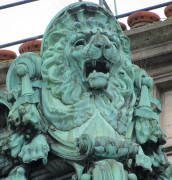
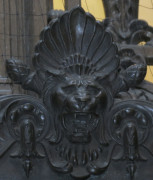
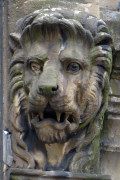 The ruff above the lion's brow.
The ruff above the lion's brow.
The bronze example above left moves to a more decorative treatment of the mane, with both a certain symmetry, and a halo-like front ruff which was a common convention on English lion heads from Victorian times through until the 1930s. The one next to it takes this upper ruff and adds a fan behind. To the right, an example of how the conventional symmetrical ruff may be combined with an otherwise naturalistic treatment of the head.
Below are more examples of lion head sculptures with rings between their jaws, each ring having depending from it hanging garlands of flowers, leaves, fruit, or in the right hand case, ribbons. Clicking on the third example to the right shows on the larger picture little lion head brackets above. A decorative use of such festoons and garlands is that it gives a block of sculpture which has a strong vertical element, as opposed to the more cubical or spherical shape of the lion face on its own.
Vertical design through hanging sculpture from the mouth. 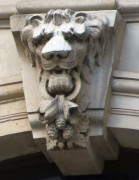
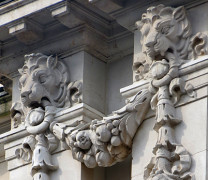

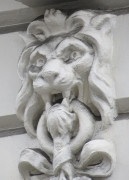
Here are some cases of lions without a ring, biting directly on the centre of a festoon of fruit or flowers to give a more horizontal decorative scheme. The problem of having a sculpture of a lion, an exemplary carnivore, biting directly on vegetation, is generally avoided by having some central wrapping, scroll or tube of acanthus actually in the mouth, as shown here. By contrast, the example on the far right shows a lion head biting on a ball, giving it a particularly fierce aspect due to the emphasis on the sharp teeth, and making the whole into a rounded or corbel shape.
Horizontal design with garlands gripped in the jaw, and spherical, with ball in the mouth. 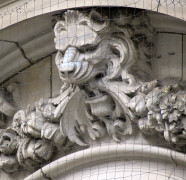
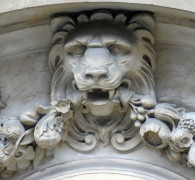

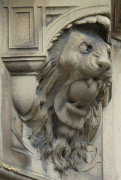
Lion head sculptures with the paws as well are found from time to time - the Marble Arch example above is one case, and below is another: this one is distinctly awkward, and a little disturbing.
Architectural pots may themselves be decorated with lion heads, following a tradition from Classical antiquity. Two examples are shown below. These are suitable for more baroque Classical buildings, where a sense of richness and opulence is given by piling decoration on decoration. The height of such embellishments may make the little lion heads difficult to see from the ground without binoculars - but this is a common problem to much architectural sculpture.
The use of architectural lion heads above principal doors, and as keystones to windows, has already been mentioned, and the photos above include several of these. Here we have a particularly effective lion head above a subsidiary door of a grand City building, part of the Bank of England, with a great sunburst of a mane, and clenching an iron chain depending from a ring in his mouth. The strange lion head in the centre acts both as a keystone to the door below, and rises behind the head to provide an accent to the sill of the window above. The keystone on the right shows how the lion head can be modified to fill the space available on the keystone shape, with a squared-off mane, and a wreath hanging from the lion's mouth being elongated from circle to oval. The distortion somehow makes the beast look particularly feral.
Lion heads make good decoration for pillars or pilasters. Rather than try and add the head to the capital of the pillar, or just above it on the entablature, in the example below, the whole shaft of the pilaster, a long vertical panel, is carved with a snarling lion head, fruit and flowers, and two hanging birds. A rather eccentric example, which brings to the mind thoughts of Snyders, the painter of still life and dead game.
 Lion head on a pillar, with game.
Lion head on a pillar, with game.
How far can we take the decorative lion head sculpture? The pictures below show some of the variety which can be found by casually wandering through the streets of major towns looking up at buildings. The first, below left, transforms the strands of fur in the mane into bouyant curves to fit with the motif of hanging, stylised flowers to left and right. Next, a crossing of bracket and a string course is marked by a lion’s head which looks fairly realistic despite the combed side mane and the lower mane being an acanthus leaf decoration depending from within the open jaws. Next, medieval in spirit but from past 1900, the sculptor makes the lion into a gargoyle, losing the entire mane bar the top ruff. And to the right, an art deco lion head with a ferocious snarl and the mane flattened and made into almost a sunburst of lines.
The second line is more extreme. Firstly a lion head on a cartouche, designed as a grotesque, with squared mouth, almost finlike side whiskers or mane, and a pointed ruff between pointed ears, yet still overall distinctly leonine. The terra cotta panel spreads the mane into a cartouche, which leaves the lion still recognisable by virtue of the extreme exaggeration to the catlike nature of the face, compelling us to see the surround as the mane. Then a charming one from a set in Albert Square, Manchester, where the mane has become the square frame of a grotesque lion head corbel. Then on the extreme right, another maneless lion, retaining only the fanciful ruff, and wtih acanthus and flowers directly issuing from the mouth.
More examples below with something of a deco look to the mane, though in some cases they are from far earlier, not just mid Victorian but even before that. Note that again some of these contrast a naturalistic head with an extremely stylised mane, in a way which does not appear incongruent or strange to the viewer.
In passing, we should say something of a particular class of lion head sculpture, which is the Assyrian lion head - there are beautiful original examples from Niniveh in the British Museum. The breed is characterised by a mane similar at the top, sides, and under the chin, going far back on the neck rather than outwards, so giving a woolly rather than fluffed out conventional leonine mane, and typically carved in very small regular tufts rather than great swirls and curls about the face. This one is a modern example, from the Bomber Command Memorial in Green Park, dating from 2012, inspired by a model from over two and a half thousand years ago.
As well as architectural pots, lion heads can be associated with other architectural sculpture. Below left is a keystone, depicting a warlike Athena with her Corinthian helmet, with its crest as the head and forepaws of a lion - you will need to click to enlarge to see this one properly. Below right something in rather less refined taste: two atlantes (see the page on Caryatids and Atlantes), shown as figures of Hercules, with the paws of lion skins hanging down, and the lion heads acting as some sort of codpieces.
Lest we get too carried away, we finish with a few more conventional lion head sculptures. These have in common that they are all on a shield-like backing, curved or rounded or cartouche, with the lion head as the boss.
Lion head sculpture as shield bosses. 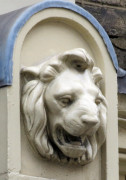
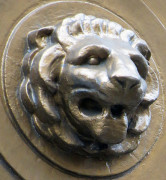
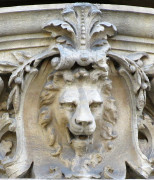
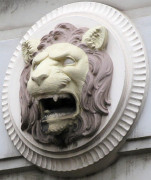
Hopefully this page gives some idea of the range and variety of architectural lion head sculpture as used by the Victorians and Edwardians, and in particular, if you, oh reader, are an architect, then perhaps this may encourage you to improve your next building with a lion head or two.
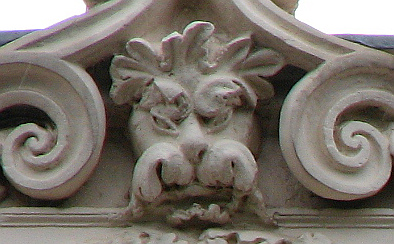
A less dignified lion head.
Lion sculpture // Other animal sculpture // Allegorical sculpture
Architecture // London sculpture // Sculpture in England // Sculpture pages
Visits to this page from 31 July 2013: 41,665